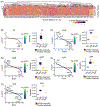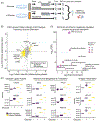Integrated changes in thermal stability and proteome abundance during altered nutrient states in Escherichia coli and human cells
- PMID: 36082775
- PMCID: PMC10782824
- DOI: 10.1002/pmic.202100254
Integrated changes in thermal stability and proteome abundance during altered nutrient states in Escherichia coli and human cells
Abstract
Altered thermal solubility measurement techniques are emerging as powerful tools to assess ligand binding, post-translational modification, protein-protein interactions, and many other cellular processes that affect protein state under various cellular conditions. Thermal solubility or stability profiling techniques are enabled on a global proteomic scale by employing isobaric tagging reagents that facilitate multiplexing capacity required to measure changes in the proteome across thermal gradients. Key among these is thermal proteomic profiling (TPP), which requires 8-10 isobaric tags per gradient and generation of multiple proteomic datasets to measure different replicates and conditions. Furthermore, using TPP to measure protein thermal stability state across different conditions may also require measurements of differential protein abundance. Here, we use the proteome integral stability alteration (PISA) assay, a higher throughput version of TPP, to measure global changes in protein thermal stability normalized to their protein abundance. We explore the use of this approach to determine changes in protein state between logarithmic and stationary phase Escherichia coli as well as glucose-starved human Hek293T cells. We observed protein intensity-corrected PISA changes in 290 and 350 proteins due to stationary phase transition in E. coli and glucose starvation, respectively. These data reveal several examples of proteins that were not previously associated with nutrient states by abundance alone. These include E. coli proteins such as putative acyl-CoA dehydrogenase (aidB) and chaperedoxin (cnoX) as well as human RAB vesicle trafficking proteins and many others which may indicate their involvement in metabolic diseases such as cancer.
Keywords: E. coli stationary phase; glucose starvation; isobaric peptide tagging; ligand-protein interactions; proteome integral stability alteration assay.
© 2022 Wiley-VCH GmbH.
Conflict of interest statement
CONFLICT OF INTEREST
The authors declare no conflict of interest.
Figures






Similar articles
-
The functional proteome landscape of Escherichia coli.Nature. 2020 Dec;588(7838):473-478. doi: 10.1038/s41586-020-3002-5. Epub 2020 Dec 9. Nature. 2020. PMID: 33299184 Free PMC article.
-
Improved drug target deconvolution with PISA-DIA using an extended, overlapping temperature gradient.Proteomics. 2024 Aug;24(16):e2300644. doi: 10.1002/pmic.202300644. Epub 2024 May 20. Proteomics. 2024. PMID: 38766901
-
Thermal proteome profiling in bacteria: probing protein state in vivo.Mol Syst Biol. 2018 Jul 6;14(7):e8242. doi: 10.15252/msb.20188242. Mol Syst Biol. 2018. PMID: 29980614 Free PMC article.
-
Thermal proteome profiling: Insights into protein modifications, associations, and functions.Curr Opin Chem Biol. 2022 Dec;71:102225. doi: 10.1016/j.cbpa.2022.102225. Epub 2022 Nov 8. Curr Opin Chem Biol. 2022. PMID: 36368297 Review.
-
Characterizing protein-protein interactions with thermal proteome profiling.Curr Opin Struct Biol. 2024 Dec;89:102946. doi: 10.1016/j.sbi.2024.102946. Epub 2024 Oct 30. Curr Opin Struct Biol. 2024. PMID: 39481280 Review.
Cited by
-
Rapid recruitment and IFN-I-mediated activation of monocytes dictate focal radiotherapy efficacy.Sci Immunol. 2023 Jun 2;8(84):eadd7446. doi: 10.1126/sciimmunol.add7446. Epub 2023 Jun 9. Sci Immunol. 2023. PMID: 37294749 Free PMC article.
-
Protein interactions in human pathogens revealed through deep learning.Nat Microbiol. 2024 Oct;9(10):2642-2652. doi: 10.1038/s41564-024-01791-x. Epub 2024 Sep 18. Nat Microbiol. 2024. PMID: 39294458 Free PMC article.
-
Profiling Proteins and Phosphorylation Sites During T Cell Activation Using an Integrated Thermal Shift Assay.Mol Cell Proteomics. 2024 Jul;23(7):100801. doi: 10.1016/j.mcpro.2024.100801. Epub 2024 Jun 15. Mol Cell Proteomics. 2024. PMID: 38880243 Free PMC article.
-
Comparative Analysis of Protein Folding Stability-Based Profiling Methods for Characterization of Biological Phenotypes.J Am Soc Mass Spectrom. 2023 Mar 1;34(3):383-393. doi: 10.1021/jasms.2c00248. Epub 2023 Feb 20. J Am Soc Mass Spectrom. 2023. PMID: 36802530 Free PMC article.
References
-
- Molina DM, Jafari R, Ignatushchenko M, Seki T, Larsson EA, Dan C, Sreekumar L, Cao Y, & Nordlund P (2013). Monitoring drug target engagement in cells and tissues using the cellular thermal shift assay. Science, 341, 84–87. - PubMed
-
- Franken H, Mathieson T, Childs D, Sweetman GMA, Werner T, Tögel I, Doce C, Gade S, Bantscheff M, Drewes G, Reinhard FBM, Huber W, & Savitski MM (2015). Thermal proteome profiling for unbiased identification of direct and indirect drug targets using multiplexed quantitative mass spectrometry. Nature Protocols, 10, 1567–1593. - PubMed
-
- Savitski MM, Reinhard FBM, Franken H, Werner T, Savitski MF, Eberhard D, Molina DM, Jafari R, Dovega RB, Klaeger S, Kuster B, Nordlund P, Bantscheff M, & Drewes G (2014). Tracking cancer drugs in living cells by thermal profiling of the proteome. Science, 346, 1255784. - PubMed
Publication types
MeSH terms
Substances
Grants and funding
LinkOut - more resources
Full Text Sources
Molecular Biology Databases

